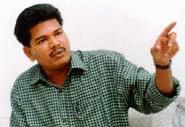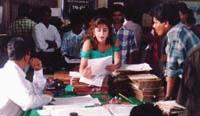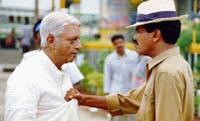 For a director, the moment of reckoning comes along with the Censor Board certificate that clears his latest film for release on the marquee. For it is at that point that he faces the most crucial question of all - the question of whether his cinematic vision will strike a sympathetic chord in the audience.
For a director, the moment of reckoning comes along with the Censor Board certificate that clears his latest film for release on the marquee. For it is at that point that he faces the most crucial question of all - the question of whether his cinematic vision will strike a sympathetic chord in the audience.
Shankar is perhaps the only exception, right now, to this rule - at least, among the southside directors. Reason being, one week before his latest opus, Indian, was due for release, the box office had sold out every single ticket for one whole month.
In other words, 30 days of houseful run guaranteed, before the film is even released - which is good going for a young man now into only his third film.
It is an enviable position to find himself in, and Shankar owes it to the fact that his first two films, Gentleman and Kaadalan (the latter released in Hindi as Humse Hain Muqabala) were mammoth hits.
But more than the two previous outings, it is on Indian that Shankar's immediate future hinges. For one thing, a hit here and his position as the hottest property in south Indian cinema is  assured for all time. For another, he has an unparalleled line-up of stars and technicians - Santosh Sivan behind the camera, A R Rehman composing the music, national award winner Thota Tharani designing the sets, the Prabhu Deva family and Bollywood ace Saroj Khan choreographing the dances, and a star line up that reads Kamal Hassan, Manisha Koirala, Urmila Matondkar (seen here, with the director, right).
assured for all time. For another, he has an unparalleled line-up of stars and technicians - Santosh Sivan behind the camera, A R Rehman composing the music, national award winner Thota Tharani designing the sets, the Prabhu Deva family and Bollywood ace Saroj Khan choreographing the dances, and a star line up that reads Kamal Hassan, Manisha Koirala, Urmila Matondkar (seen here, with the director, right).
The team is a director's dream and, he adds grinning, also a director's nightmare for if he does not deliver with this line-up, then he is finished as far as big projects go.
So who is this man? Shankar was a wannabe actor who, after small and unnoticed roles in two films, ended up grabbing a chance to assist director S A Chandrasekhar. Of the 15 films Shankar worked on under Chandrasekhar, two happened to be for movie mogul Kunjumon. Thus, when the latter wanted a new director to handle a mega-budget project, he thought of Shankar. It was thus that the young man, then in his late twenties, got Gentleman. And the rest, as they say, is history...
Taking time off from the work of dubbing Indian in Hindi for release on the Bollywood marquee in mid-June, Shankar spoke to Rediff On The NeT at length on his cinematic vision. Excerpts from his conversation with Rajitha:
Your biggest project to date is hitting the marquee, do you feel the tension?
No. Honestly not. For me, the time of tension is when I am first consumed by the idea of a film. As the idea grows, from a spark to a flame that sweeps through my imagination, I am tense, taut, anxious about getting a producer, getting the right stars, finding the right team, the right locales, translating on to screen the idea in my mind. Once the last take is canned, the film is edited and submitted to the censors, my tension is off, for there is nothing more for me to do.
Okay, so what is Indian all about?
I won't discuss the storyline, alright? I want people to see it without any preconceptions. All I can say for now is, it deals with a burning problem, an issue that touches the life of every Indian.
I will give you a clue. Look, India has everything - brilliant people, vast natural resources, immense manpower, everything. Why then are we not at the top of the international map? Why haven't we achieved as much as our potential suggests?
I address this question, and try to answer it in my own fashion in this film.
Every film of yours has a strong 'hook' for the audience. Gentleman had the Chikku Bukku song and our first look at Prabhu Deva's dancing skills, Kaadalan had all those special effects gimmicks like the transparent bus. So what is Indian's hook?
The make up. For a major part of the film, Kamal Hassan (seen, left, in his old-man get up)  Yes, there are some spectacular special effects in Indian. As for the dances, we have shot one in Australia, in Canberra actually, with Manisha and Urmila and Kamal. Very spectacular number.
Yes, there are some spectacular special effects in Indian. As for the dances, we have shot one in Australia, in Canberra actually, with Manisha and Urmila and Kamal. Very spectacular number.
I heard that for one song, you had 1,500 junior artists, was that the one shot in Australia? Very extravagant, surely?
No, that one was shot in Senji Fort, on the outskirts of Madras. Look, have you seen the place? It's huge, immense. If I had used just my stars and a dozen extras, they would have been swallowed up by the backdrop. I needed to 'fill' it in, so I used a lot of extras, around 1,500.
Whatever the reason, you have earned the reputation of being a costly director. Isn't this going to affect your career, especially given that there is a lot of concern these days about film budgets going through the roof?
Look, I don't start out by first asking myself, how much money do I have, then what kind of movie can I make with that money. For me, the idea comes first, the team next, the locations after that, the details of treatment comes next - after I have all this clear in my mind, I then think about what it will cost, and approach a producer who can finance me to the extent of whatever it takes.
Okay, maybe I tend to think big. You talk of concern for outsize budgets. The real problem is not that a lot of money is being spent, but that a lot of times, directors and producers sink money into silly ventures which flop. If money spent is earned back again, and with profit too, then there is no problem. Another thing, I always make it a point to ensure that the money that is spent does not stick out, overwhelm the film.
 To revert to Kamal for a minute - I have heard that he has a tendency to take over, to direct himself in his films. Did this become a problem?
To revert to Kamal for a minute - I have heard that he has a tendency to take over, to direct himself in his films. Did this become a problem?
Frankly, I too had heard this. But I must say this, in my film I had absolutely no problems of that sort. He was totally professional, and all along it was clear to both of us that I was the director.
Of course, he did discuss his ideas with me - after all, he is not merely a star but a superb actor as well. But such discussion is what helps improve a film, and I was only too open to suggestions. In every instance, however, the final decision was mine, it depended on what I wanted to do.
Okay, to get back to your style of film making - both critics and the public feel that you have a tendency to lean towards the spectacular. In your choice of foreign locales, in your technical slickness, in the sweep of your frames and your canvas. Are you not worried at times that this leaning to the spectacular will overshadow your story?
First, you must understand that we live in a fast food age. An age where packaging matters as much as content. So without the slickness, the technical virtuosity, the special effects, the sweeping locales, and all the rest of the trimmings, people don't get attracted - and a film-maker who cannot get people into the theatre is a failure, no matter how good a storyteller he may be.
Having said that, I must point out that in my films, these parts never overshadow the whole. I take care to see that everything is in correct proportion, and that no single element dominates. Rehman's music might be brilliant, but it is a component of the film. Santosh Sivan might have captured some stunning scenes with his camera, but that again is part of the whole. And the connecting link throughout is the story - that is what is the backbone of my films.
Look, it is like a pretty woman. Great face, great figure, great legs, great everything - why does she use cosmetics? To enhance her looks, to highlight the good points and distract attention from the little flaws. For me, my story is that "pretty woman", and all the rest of the trimmings are cosmetics.
Okay, how about violence? Gentleman had its share, in fact some scenes were positively gory. Kaadalan had its undercurrent of violence, despite purporting to be a love story. And now, Indian. More violence?
First thing to remember, violence sells. And I am a film-maker, when someone entrusts me with millions of rupees to make a film with, it is my responsibility to see that the movie runs and he gets his money back. That does not mean that I will do anything, simply to sell a film, okay? I am just putting this thing in perspective here.
About Gentleman. I know the scene you mean, where the friend of the hero dies and his heart is shown pumping, right? Okay. Now, in the story this friend wants to become a doctor, it is a desperate need. And he is denied a seat despite deserving it, so he commits suicide. And this tragedy lives on, in the mind of the hero. When making the film, I thought the pumping heart would be a good visual symbol of all this. When I saw it on screen I realised it was yucky. But remember, that was my first film, some allowance has to be made for that fact. And I have learnt since then.
As for Kaadalan, it was not a violent film. There were action scenes, but they were choreographed to show off Prabhu Deva's incredible agility and speed. Like in Jackie Chan films. Look at the climax - a bomb is planted in a hospital, and all the medical college students rush to evacuate the patients before it goes off. The planted bomb plants in your mind the mood of impending violence, of death and destruction. It creates tension in your mind. But the bomb never goes off, there is never any death or destruction except where the two villains die, see my point?
Indian? Well, there are action scenes (*grinning*) but no violence.
The big question asked these days, of course, is about censorship. Are you for? Or against?
I am against these 'general lists' and things. I mean, how can you have a generalised guideline for all films? In one film, a scene of violence might be needed by the storyline, in another it might be just part of the needless masala. Judgements should be made in context of individual films,
not on the basis of a catchall 'dos and don'ts' list.
Actually, every director has a censor peering over his shoulder - and that is his own sense of right and wrong. Like, let me tell you that when making Gentleman, I had canned several incredibly violent scenes. But when it came to the editing table, something rebelled, and I knocked those scenes out. I was being my own censor there, you see? After all, I too am human, I can be repulsed by things...
Give me an example - what form of violence would you find repulsive?
Any form of violence where children are either the perpetrators, or the victims. Violence in the context of children, I find very very repulsive.
Okay, moving on, every director when asked about his latest film talks about the message it contains. Are you into messages?
How do I answer this? When I sit down to make a film, I am not saying to myself, okay, I am going to make one with this message, alright?
For me, the first inspiration is something, some seed, from real life. Some issue, some problem, something that concerns me, that concerns my fellows.
Take Gentleman - unemployment, or more importantly under-employment, is a major concern for so many of us. You know there are post graduate students manning those bunks that are set up by the National Association for Self-Employed Youths? I think when I need to buy cigarettes or paan, that maybe I should do it only from such bunks, so that they can benefit. But when I go there and ask this MA in literature to give me a packet of cigarettes, I cringe. And it is this problem that I dealt with in Gentleman.
Take Kaadalan. Do you know what the greatest insecurity is, for a young man entering college, a youth in his mid and late teens? His looks. He sees himself in the mirror and he thinks, I look so ordinary, will any girl ever like me? And remember, this is the stage when he is first getting aware of girls and all that. It gives him an enormous complex, looms very large in his mind. And that is the kernel of Kaadalan, this question of whether or not an ordinary looking guy can find love.
As for Indian, I told you, why do we have so much, and yet find ourselves so backward as a nation?
Are these messages? I don't know, I don't think of them that way...
Have you changed after becoming a film-maker? Grown?
Yes, of course. Every human being changes, no matter what his occupation, and mine has certainly changed me.
As a film-maker, I have grown more confident. I told you how in my first film I used violence because violence sells. I also used a bit of double meaning dialogues to appeal to the front benchers. After all, it was my first film, I wanted it to succeed, so I used all the classic ingredients.
By the time I made my second film, I was secure enough to tone down these elements. To rely more on my storytelling skills, and less on ingredients, on formula. And now, in my third film, I am confident enough to explore, to experiment.
Simultaneously, as a person, I have learnt to examine the events about me with greater care, more thought, more feeling. For it is from my life and surroundings that my ideas are coming, and I find that as I get more involved in the everyday world, my thinking becomes better...
Okay, the routine last question: what next?
Well, I just finished a film, it still has to be released in Hindi, what is the hurry?
But actually, I have signed a project with Amritraj Productions. I have the seeds of an idea for the film I am going to make for them, but I haven't got down to scripting it yet...

